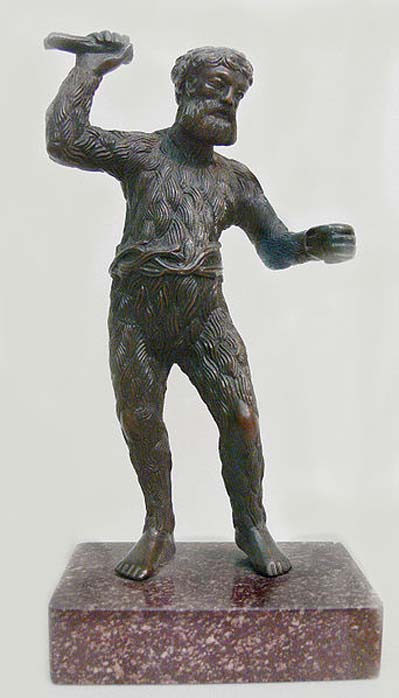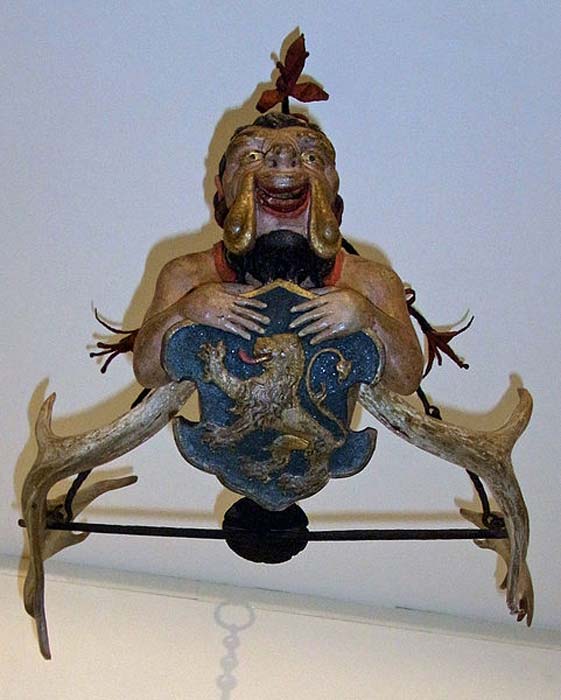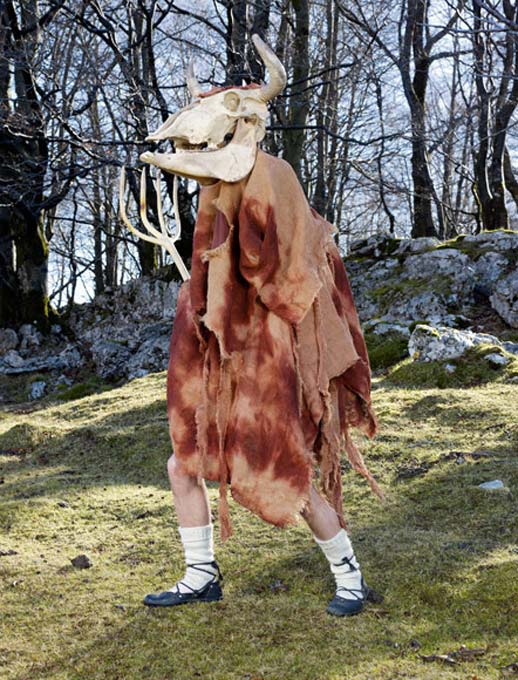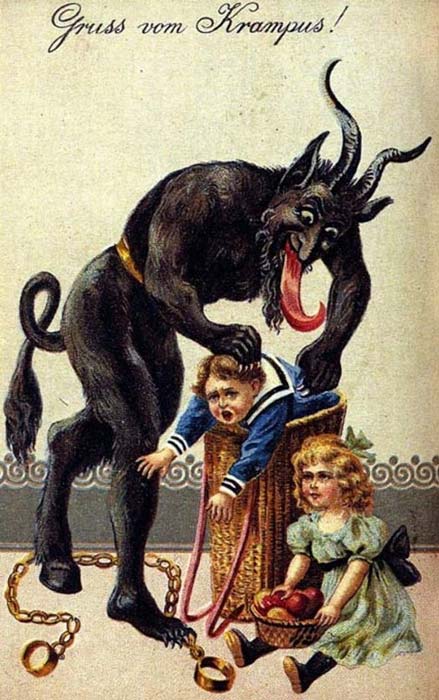
Beasts of the Pagan Wild Man Ritual Come in All Shapes and Sizes
The wild man is a creature found in various pagan traditions across Europe. Generally speaking, a wild man is a man dressed up in a beast-like costume for certain pagan rituals, which were normally aimed at providing protection from evil spirits or promoting fertility. These rituals are still practiced today in various parts of Europe, especially in rural villages.
Wild men have their roots in the pagan traditions of Europe. In spite of centuries of influence from Christianity, and subsequently, secularism, these traditions have survived, especially in the rural areas of the continent. During certain rituals, which often take place during the transition from winter to spring, men practicing these pagan traditions put on costumes, thus making the transformation into wild men.

Paulus Vischer (c. 1498-1531): Wild Man, c. 1521/22, bronze. Skulpturensammlung (inv. no. 8403, acquired in 1929), Bode-Museum, Berlin. (Public Domain)
A Wild Man as a Bear
However, in certain areas these traditions merged with the Christian faith that replaced pagan ways. For instance, in Mamoiada, a small village in Sardinia, wild men are part of a ritual that takes place on the Feast of Saint Anthony the Great, which falls on January 17th. For this ritual, there are two groups of wild men, the Mamuthones, who represent the darkness, and the Issohadores, who represent the light.
- The Reog Ponorogo: A Dance of Rebellion Which Changed History
- A Window into the Traditional Sami Culture: Reindeer and a Worldview
- New Year’s Traditions around the World and Their Origins
Whilst wild men come in all shapes and sizes, it may be said that their costumes are normally meant to be menacing. In Germany, for example, men dress up as the Reisigbar, which is a bear wearing a mask and dressed in twigs. The bear is closely associated with the wild man in many European cultures. In some, this is also regarded as its father. The bear’s ability to walk on two legs makes it seem like a human being. Additionally, the animal’s habit of hibernating during the winter, and its re-awakening during spring is symbolic of death and re-birth. These aspects of the bear strike a chord in the hearts of those participating in the pagan wild man rituals.

Geweihleuchter "Wilder Mann" ("Schreckkopf") North Germany before 1575. (Public Domain)
Apart from animals, wild man costumes may also represent fantastic beasts not found in the animal kingdom. The people of Spain’s Basque Country, for example, dress up as the Zezengorri, a creature recognized by its bare skull and pitchfork.

Zezengorri, a wild man in Spain’s Basque Country. (Ernie Omega)
Differing Roles for A Wild Man
Whether they assume the form of an animal, or some other strange creature, there is good reason for wild men to take on such a ferocious appearance. In many of these pagan rituals, the wild man is supposed to protect villages by scaring away evil spirits, or to chase winter away and welcome spring. Therefore, having a fierce demeanor is particularly useful for such tasks.
In some cultures, a wild man has different roles to play. In some Alpine countries, including Austria, Hungary, and Slovenia, for instance, there is the Krampus, a beastlike creature who served as the counterpart of Santa Claus. Whilst Santa Claus brings presents to good kids, the Krampus visits the naughty ones to punish them.

According to tradition, Krampus devours naughty children. ( Public Domain )
In other pagan rituals, wild men have the task of promoting fertility in the land, livestock, and even women. In Bulgaria, for example, there are the Babugeri and the Chaushi. The costumes of these wild men are made of goat skin, and traditionally, they carried a red-colored rod that represented a phallic object. They would brush this rod up against a woman to make her fertile. Today, the phallic rod is replaced by a stick.
- Santa’s Horned Helper: The Fearsome Legend of Krampus, Christmas Punisher
- Christkind: How Does this Christmas Gift-Bringer Differ from Santa Claus?
- Oval Huts, Dairy Temples and Holy Milkmen: How a Secluded Existence Produced the Idiosyncratic Toda Traditions
Documenting Wild Men
Lastly, it may be said that these pagan rituals involving the wild man were brought to a wider audience thanks to a French photographer by the name of Charles Fréger. Over a course of two years, Fréger visited more than 50 villages in 19 European countries in order to document the wild men and their pagan rituals. Fréger’s work was displayed as a series entitled “Wilder Mann” at the Yossi Milo Gallery in New York, and is also available as a monograph called Wilder Mann: The Image of Savage.
Top image: Kukeri is a type of wild man in Bulgaria. Rituals with this ‘beast’ are believed to scare away evil spirits. Source: Klearchos Kapoutsis/CC BY 2.0
By Wu Mingren
References
Rosenberg, D., 2013. Capturing the Still-Practiced Pagan Rituals of Europe. [Online]
Available at: http://www.slate.com/blogs/behold/2013/04/12/charles_fr_ger_wilder_mann_examines_pagan_rituals_throughout_europe_photos.html
Sergova, E., 2017. Wild men: the ancient pagan ritual that still thrives in rural Bulgaria. [Online]
Available at: https://www.calvertjournal.com/photography/show/7956/kukeri-pagan-ritual-bulgaria
Shea, R. H., 2013. Europe's Wild Men. [Online]
Available at: http://ngm.nationalgeographic.com/2013/04/europes-wild-men/shea-text
sobadsogood.com, 2013. Scary Monsters & Wild Men: The Costumes of Pagan Rituals. [Online]
Available at: http://sobadsogood.com/2013/10/16/wilder-mann-photographic-series-by-charles-freger-monsters-men-a-look-at-the-costumes-of-pagan-rituals/
Somvichian-Clausen, A., 2017. Inside an Ancient Pagan Ritual That Makes Men Become Monsters. [Online]
Available at: http://news.nationalgeographic.com/2017/10/ancient-ritual-pagan-sardinia-monsters/
Stinson, L., 2013. The Bizarre, Eye-Popping Costumes of Europe’s Wild Men. [Online]
Available at: https://www.wired.com/2013/08/the-gorgeous-costumes-of-europes-wild-men/
















Comments
Krampas is based on the Christian devil, or the other way around. being raised Catholic, which one is real and which one is a myth. interesting article none the less.
riparianfrstlvr